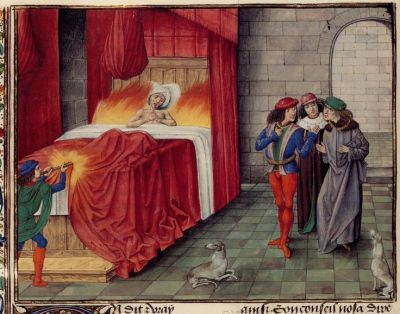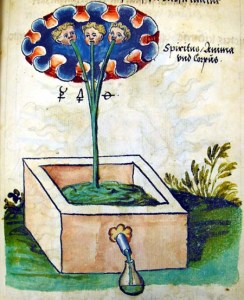Your Halloween Post, Plus An Answer To Your Dad’s Question „How Is Studying Medieval History In Any Way Useful?“
 I’ve been hesitating to write about this incident for some time. I have a couple of guidelines for my Halloween posts that are not easy to meet: the post must be horror-themed, it must be about a true story, but it may not treat human suffering as a source of amusement. (I guess that pretty much encapsulates the problem with Halloween as such.) I therefore must apologize to my readers in advance that this post deals with an absolutely horrific death that I wouldn’t wish on my own worst enemy. If it makes any difference, the victim was a very, very bad person. Very bad. So bad, in fact, that „the Bad“ became his royal moniker. I am, of course, talking about Charles the Bad a/k/a Charles Le Mauvais(*) a/k/a Charles II, King of Navarre from 1349 to 1387.
I’ve been hesitating to write about this incident for some time. I have a couple of guidelines for my Halloween posts that are not easy to meet: the post must be horror-themed, it must be about a true story, but it may not treat human suffering as a source of amusement. (I guess that pretty much encapsulates the problem with Halloween as such.) I therefore must apologize to my readers in advance that this post deals with an absolutely horrific death that I wouldn’t wish on my own worst enemy. If it makes any difference, the victim was a very, very bad person. Very bad. So bad, in fact, that „the Bad“ became his royal moniker. I am, of course, talking about Charles the Bad a/k/a Charles Le Mauvais(*) a/k/a Charles II, King of Navarre from 1349 to 1387.

 Lets begin by dispelling a common misconception among the movie’s following: Julian Marty is not Greek — at least not literally. He merely references Greece in conversation parallel to how Loren Visser references Russia. Thus, the subtext of the movie immediately sets up this juxtaposition: Greece, the land of civilization, versus Russia, the land of bears. But then, the Coens immediately complicate it by assigning each symbol the other’s qualities: Greece is where “they cut off the head of the messenger” if he brings bad news, and Russia is an ordered society where everyone pulls for everyone else (“that’s the theory, anyway”, as Visser qualifies it). The line between civilization and nature, order and chaos, refinement and barbarity, reason and impulse, can never be presumed — and nowhere is this more true than in a watering hole.
Lets begin by dispelling a common misconception among the movie’s following: Julian Marty is not Greek — at least not literally. He merely references Greece in conversation parallel to how Loren Visser references Russia. Thus, the subtext of the movie immediately sets up this juxtaposition: Greece, the land of civilization, versus Russia, the land of bears. But then, the Coens immediately complicate it by assigning each symbol the other’s qualities: Greece is where “they cut off the head of the messenger” if he brings bad news, and Russia is an ordered society where everyone pulls for everyone else (“that’s the theory, anyway”, as Visser qualifies it). The line between civilization and nature, order and chaos, refinement and barbarity, reason and impulse, can never be presumed — and nowhere is this more true than in a watering hole.




 The cultural phenomenon of grossly overrating the mediocre never ceases to fascinate me. Some of these are easy targets: Spectator sports. Weddings. Traditional family values. But there are some rather meh people, stories and cultural widgets that have truly achieved the status of sacred cows, and I would like to devote this Friday to tearing some of them down. And so, a random selection from my list of horribly overrated, but actually mediocre, people, events, places and phenomena:
The cultural phenomenon of grossly overrating the mediocre never ceases to fascinate me. Some of these are easy targets: Spectator sports. Weddings. Traditional family values. But there are some rather meh people, stories and cultural widgets that have truly achieved the status of sacred cows, and I would like to devote this Friday to tearing some of them down. And so, a random selection from my list of horribly overrated, but actually mediocre, people, events, places and phenomena: 
You must be logged in to post a comment.